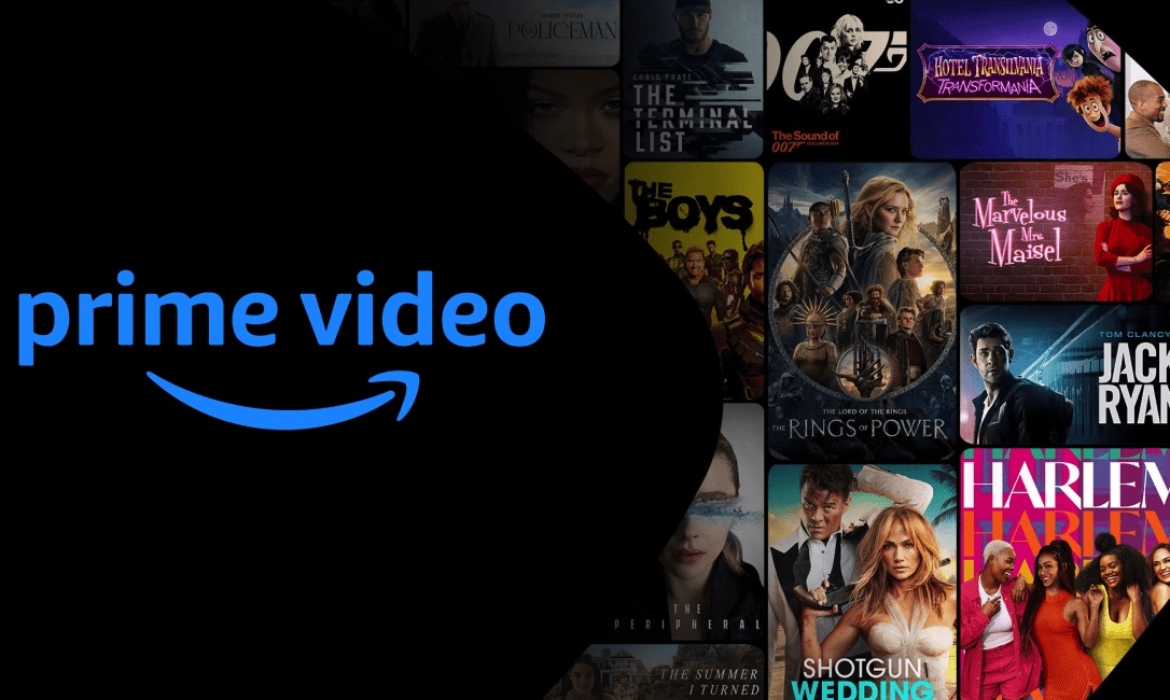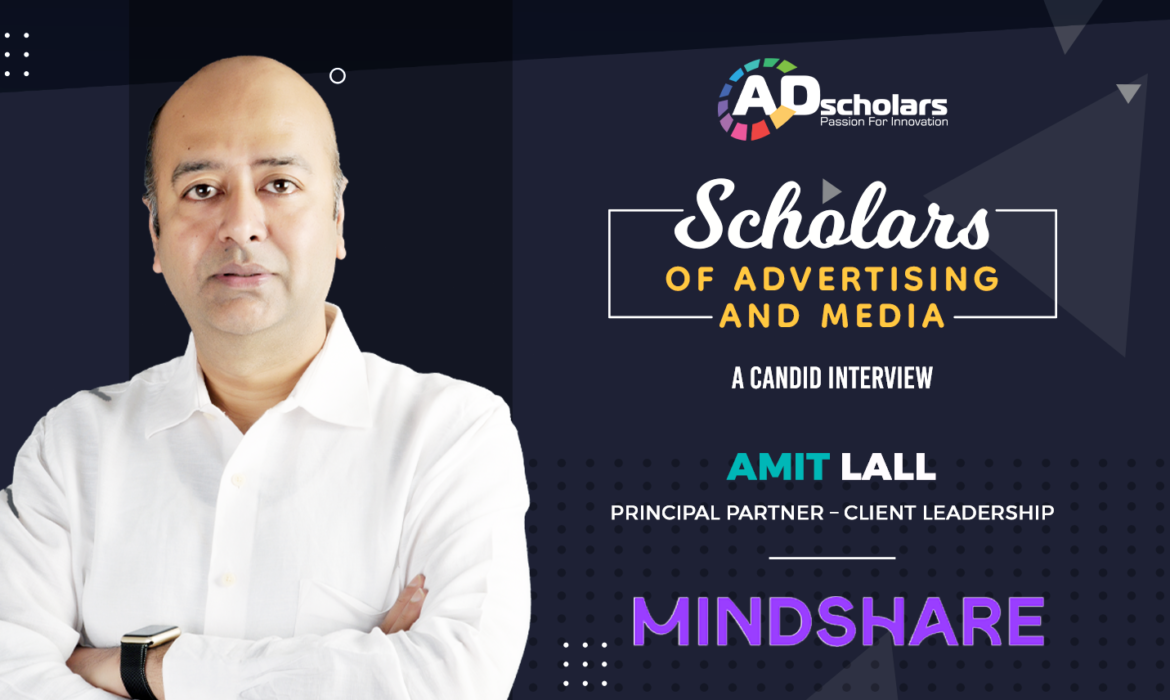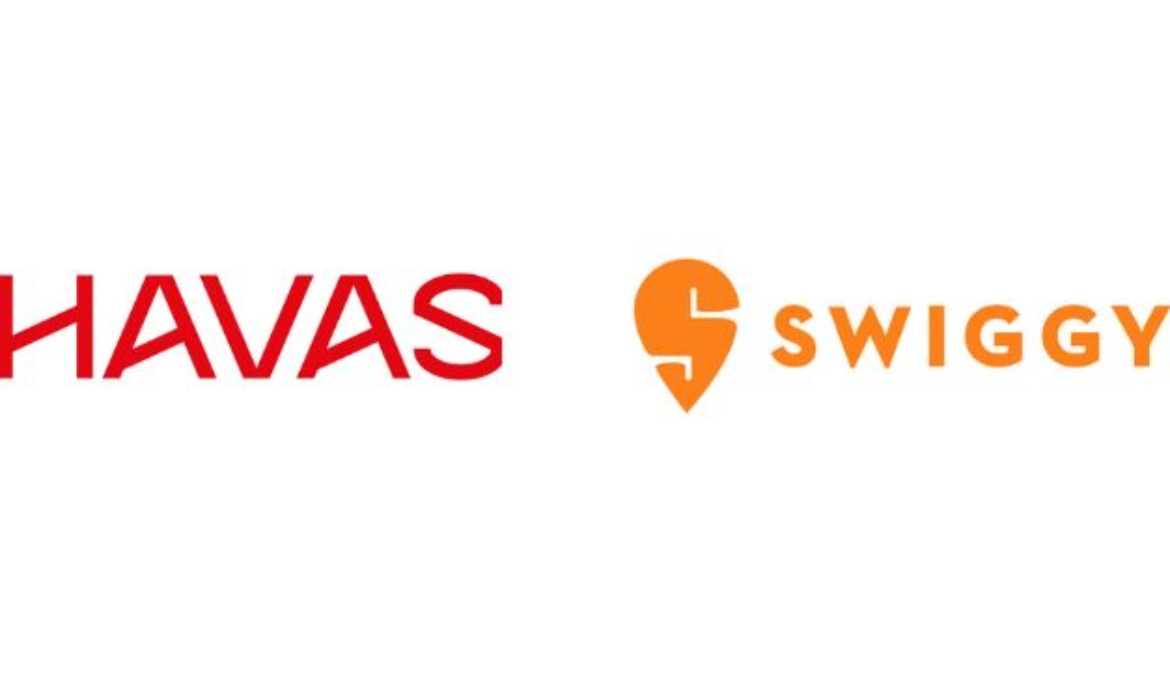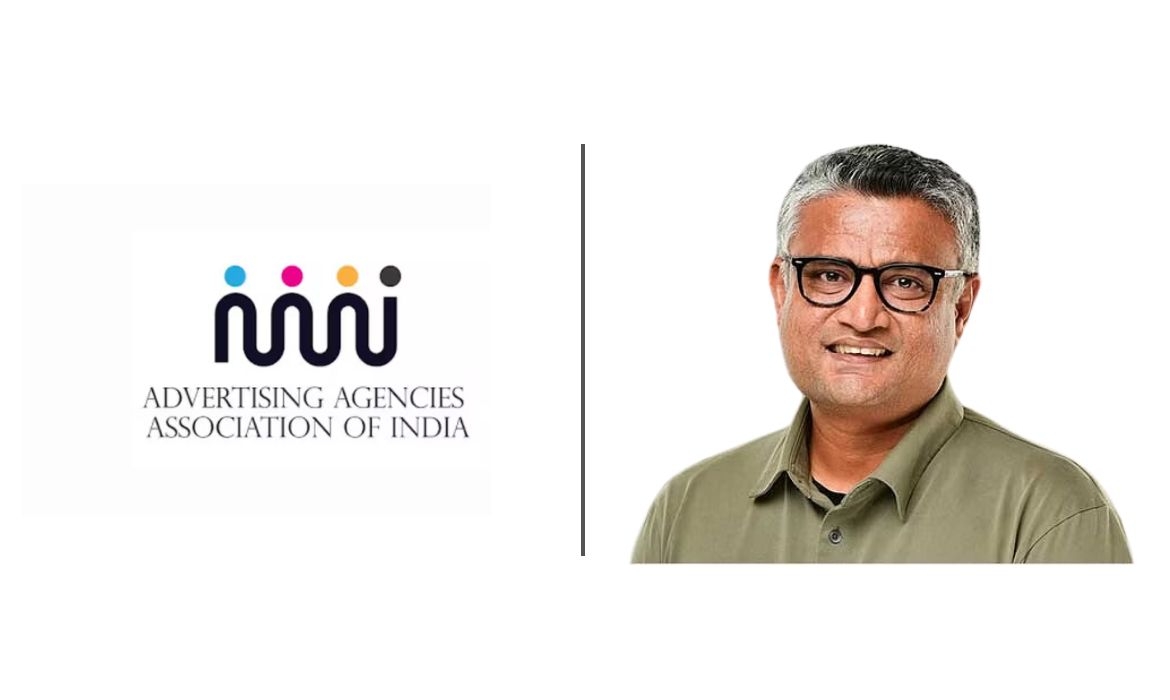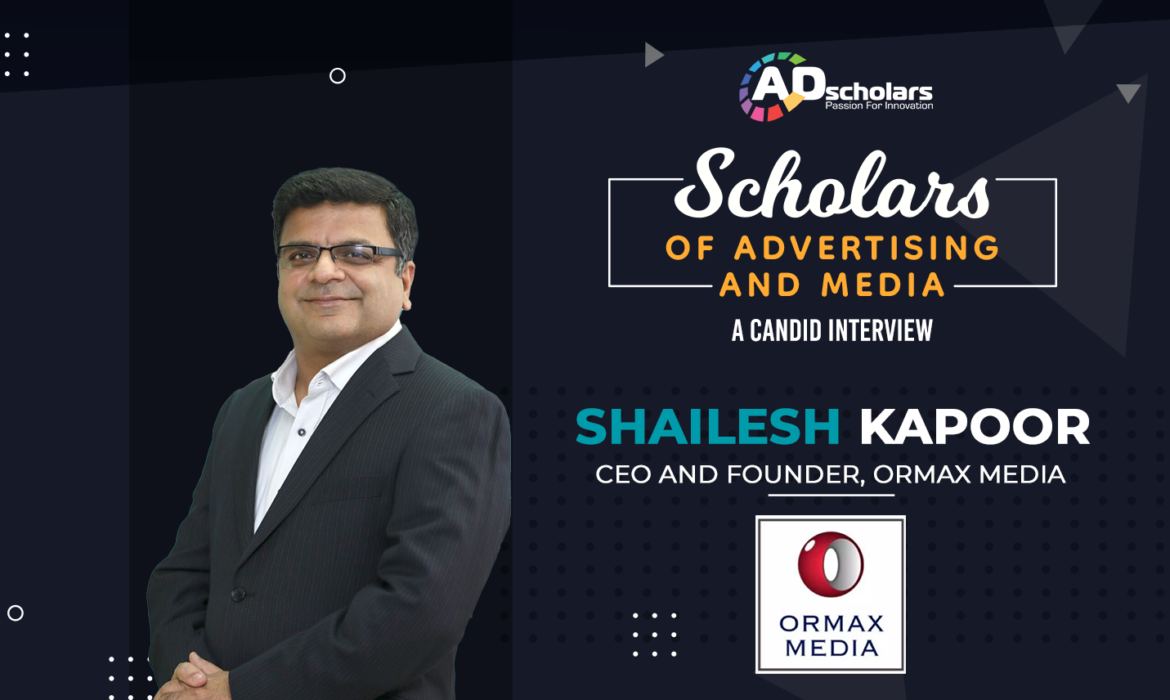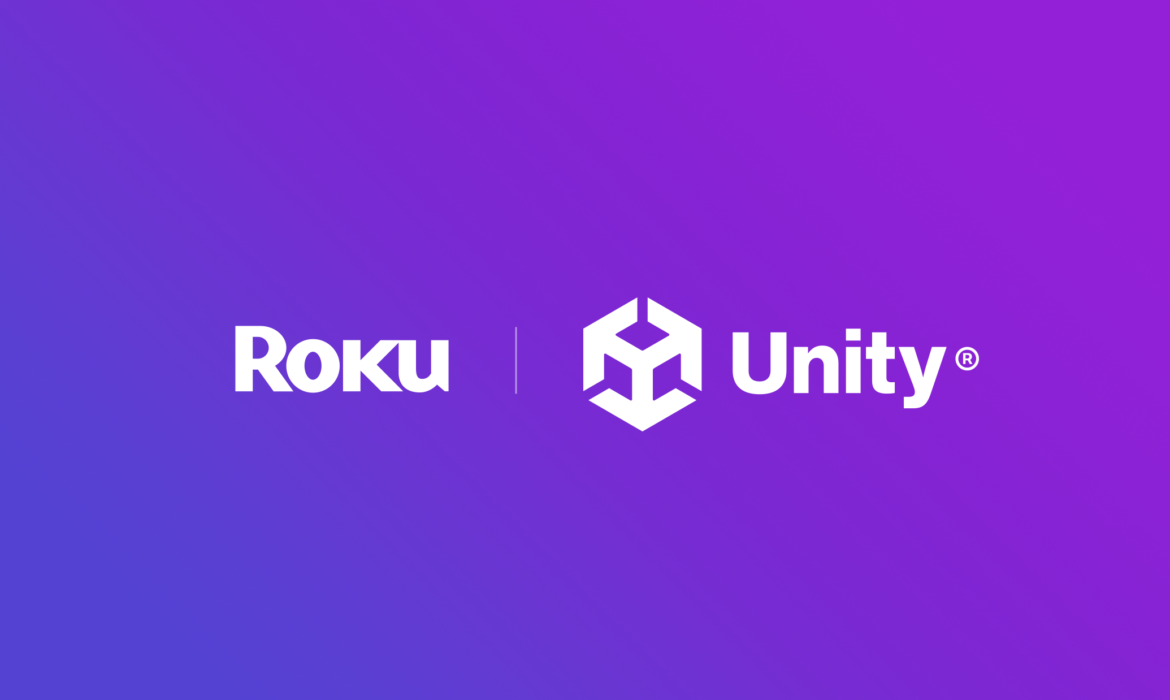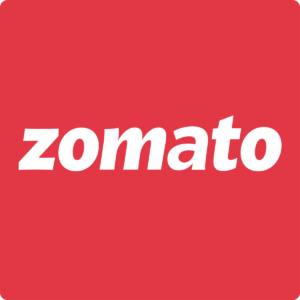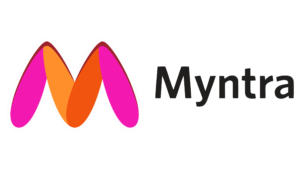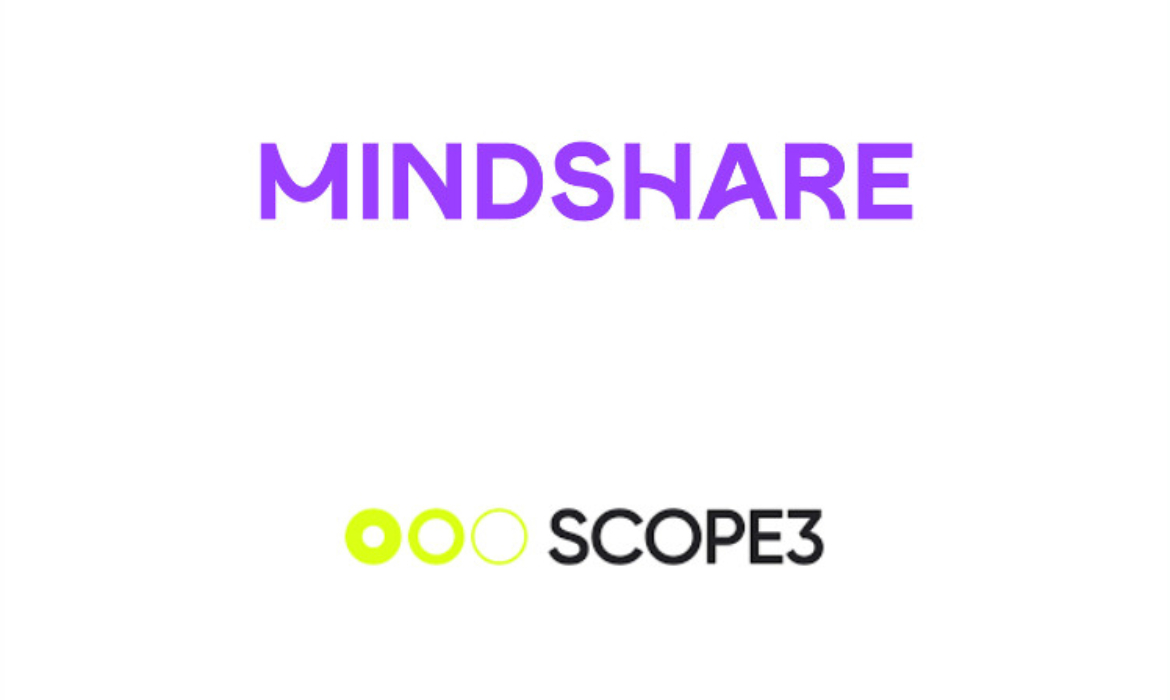Amazon Ads and IPG Mediabrands Ink 3-year Deal for Upcoming Prime Video Ads
Amazon’s video advertising division is about to take off. To support the launch of Prime Video Ads next year, Amazon Ads and IPG Mediabrands have inked a three-year deal. When limited commercials for TV series and movies on Prime Video debut in early 2024, the partnership will use Prime Video Ads to connect brands with relevant audiences. With this new offering, IPG Mediabrands is the first media holding company to collaborate with Amazon Ads. The first countries where Prime Video Ads will be available are the United States, the United Kingdom, Germany, and Canada. Later this year, France, Italy, Spain, Mexico, and Australia will be added. In 2024, IPG Mediabrands will provide support to each of these nations.
Key features of Amazon Prime Video Ads
Along with first-look opportunities to test new models and ad formats, as well as content sponsorships in each region, Amazon Ads and IPG Mediabrands will work together to help brands incorporate global Prime Video audiences into their media strategies. With the help of Amazon’s first-party shopping and entertainment insights, IPG Mediabrands advertisers will be able to connect with and engage streaming audiences and generate relevant ad experiences for Prime Video viewers. Additionally, they will be able to use Amazon’s data and research regarding viewers’ viewing and shopping habits to guide their marketing strategies.
How will advertisers benefit from Amazon Prime Video ads?
In September, Amazon announced that Prime Video, one of the last popular streaming services to forgo putting frequent commercial breaks in its films and television series, would begin doing so early the following year. An estimated 115 million people in the US will see Prime Video ads each month. Amazon seeks to have noticeably fewer advertisements than other streaming TV services and traditional linear TV. Simultaneously, it will give advertisers reach, frequency, and the ability to customize their messages, . Currently, a $14.99 monthly Prime Video subscription is included in the $139 annual Prime Subscription. All Prime members will transition to an ad-supported model as part of the plan, but they can choose to continue watching Amazon Prime Video without advertisements for an additional $2.99 per month in the U.S.
The introduction of Prime Video’s ad tier has been eagerly anticipated by advertisers, especially because of the immediate and sizable audience it will provide. In contrast, other streaming services have had difficulty increasing the proportion of their user base that is ad-supported. To help them create relevant ad experiences for Prime Video audiences, advertisers through IPG Mediabrands will also benefit from Amazon’s insights. These are generated through its shopping and entertainment platforms.
Read More: Amazon Enters Generative AI Scene With Its Chatbot “Q”
Competitors serving the ads in the streaming service market
Amazon is making a big advertising push now that several competitors have joined the market. This year, Netflix even tried an upfront sales model. However it has struggled to provide the volume of impressions that many large advertisers claim they require. Additionally, the executive team in charge of Netflix’s outreach to media buyers and marketers has been reorganized. Disney has also allowed advertisements on Disney+.
Amazon Prime – A one-stop destination for entertainment
Prime is a one-stop entertainment destination that offers customers a vast selection of premium entertainment in a single application. Customers can find all of their favorite films and television shows on Prime Video. It can be live sports, entertainment from Amazon MGM Studios and other studios, third-party channels that are available as an add-on subscription through Prime Video Channels. Moreover, they can also find movies and series that can be rented or purchased through the Prime Video store.
IPG Mediabrand’s wide range of iconic clientele
A division of Interpublic Group, IPG Mediabrands is responsible for media and marketing solutions. IPG Mediabrands oversees more than $47 billion in marketing investment globally on behalf of its clients. This is across its full-service agency network, UM, Initiative, Mediahub, and through its award-winning specialized business units, Healix, Kinesso, Magna, Mediabrands Content Studio, Orion Holdings, Rapport, and the IPG Media Lab. Among the many well-known and iconic brands in the world are those from IPG Mediabrands’ diverse portfolio of industry sectors, which includes automotive, e-commerce, direct to consumer and e-commerce, retail, hospitality, food and beverage, pharma, health and wellness, entertainment, financial services, energy, toys, and gaming. Some of their clientele are well-known marketers such as Johnson & Johnson, CVS, American Express, Mattel, Henkel, and General Mills.
Read More: Amazon Announces Publisher Cloud to Plan Programmatic Deals in Amazon DSP
Here’s what they said
Eileen Kiernan, global CEO of IPG Mediabrands said,
Amazon’s latest offering brings a first-to-market opportunity for our clients to reach consumers at the category level in a comprehensive, scalable way—from culture and content to commerce and shoppable experiences. We are excited to play a role in this game-changing addition to the streaming TV marketplace and serve as Amazon’s anchor partner as they bring Prime Video ads to life.
Alan Moss, vice president of global sales for Amazon Ads added,
From our first conversations, IPG Mediabrands has leaned in so that their clients can be among the first brands to engage with the Prime Video streaming audience across the nine countries we’ll serve starting in early 2024. When we begin introducing limited ads into Prime Video shows and movies, Prime Video will be one of the largest premium ad-supported services in most countries where we operate. This means we can simultaneously offer brands unmatched reach and frequency to help them achieve their business goals.
Dani Benowitz, global president of MAGNA, the investment and intelligence arm of IPG Mediabrands stated,
As longtime partners of Amazon Ads, we are thrilled to participate in a global deal of this scale across all of the countries in which Prime Video ads will launch throughout 2024. The ability to access the entire Amazon streaming TV product suite is an added benefit for both endemic and non-endemic brands within our broad client portfolio.
Read More: GroupM and Amazon Ads Partner for Creator-Led Shoppable Format
In Conversation with Mindshare’s Amit Lall: Mastering Digital Dynamics
Amit Lall, Principal Partner at Mindshare, brings two decades of expertise in telecom, technology, and digital planning. He oversees digital strategies for diverse sectors, prioritizing consumer-centric solutions powered by data.
In this exclusive interview, his insights will unveil the evolving media landscape, technological adaptations, and future trends, offering readers a glimpse into transformative digital initiatives propelling clients to sustainable success.
As an accomplished expert with over two decades of experience in this industry, can you walk us through your background and your experience working as the Principal Partner / Digital Lead – Client Leadership at Mindshare?
Mobile and technology have been my lifelong passions. I embarked on my professional journey with the telecom industry, initially in sales and later transitioning into product management, eventually finding my way into the realm of digital planning. This path has been characterised by a multitude of highs and lows, each contributing to my growth. Presently, I serve as a Principal Partner at Mindshare, where I oversee digital for West 1 cluster. The continually evolving digital landscape, coupled with the increasing influence of cutting-edge technologies like AI and ML, ensures that my work remains both exhilarating and challenging.
A wide range of clients come under your wing, from Fintech to Telecom to Fashion. How do ensure that the strategies employed for these sectors resonate with the specific audiences? Are there different digital strategies for each of them and if so, how do they differ from each other?
In the ever-evolving realm of brand management, a one-size-fits-all solution is elusive. Crafting effective strategies relies on a meticulous understanding of the specific objectives tied to the media task at hand. Our approach is tailored to align with the unique goals each brand aspires to achieve. Throughout the formulation process, we prioritize understanding the brand’s position in the consumer funnel. Whether the brand is emerging, established, or grappling with low consumer consideration, recognizing the brand’s needs is vital. We require absolute clarity on these points before delving into the realm of solutioning.
Furthermore, comprehensive details on the brand, its category, and its competitive landscape are indispensable. The better we know your brand, the more refined our solutioning becomes. These insights play a pivotal role in shaping communication and deployment strategies. Our solutioning is focused on an an audience-first approach, supported by robust data, powerful insights, and compelling content. By addressing these critical questions and staying committed to an audience-centric approach, we ensure that our solutions are not just effective but also resonate with the core essence of the brand.
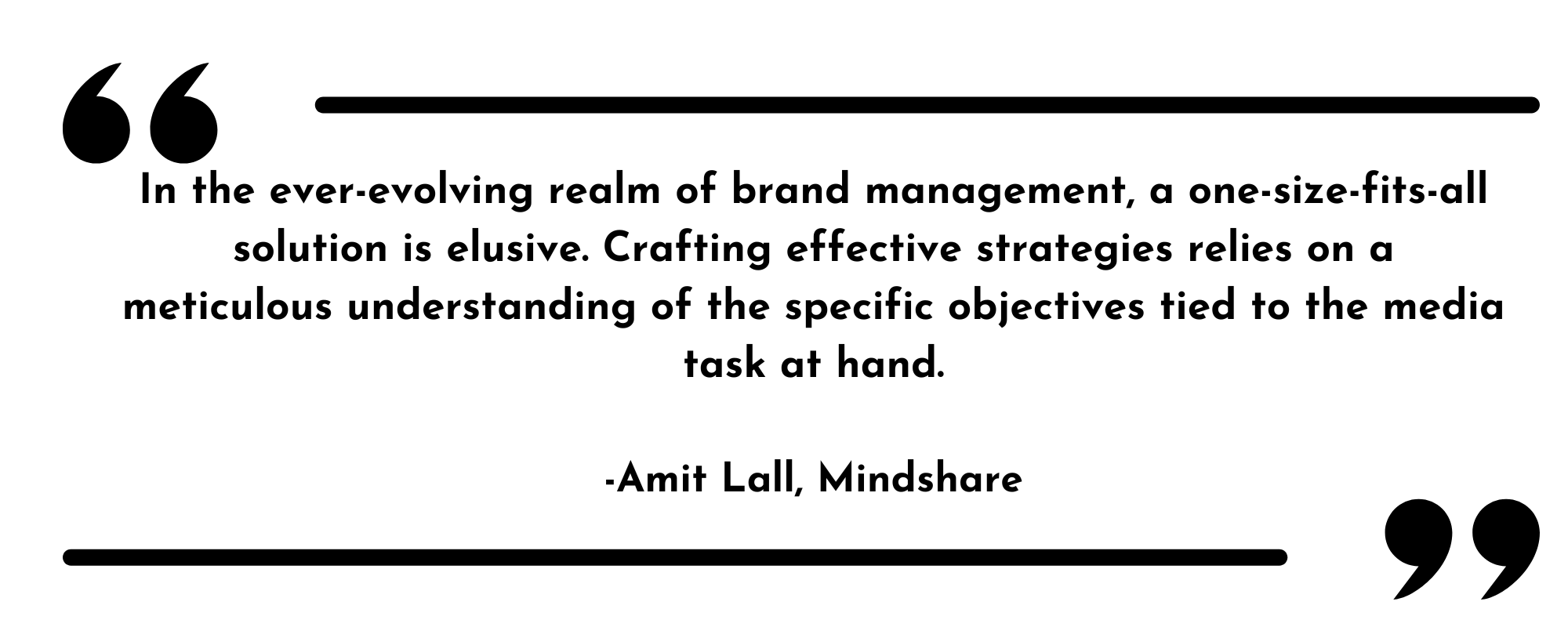
In the context of cutting-edge technologies such as Generative AI, Metaverse, and 5G, how have you prepared yourself to embrace them? How have they disrupted the advertising industry?
To be transparent, navigating the multitude of changes in the tech space, whether in Generative AI, the Metaverse, Blockchain, or Web 3.0, can indeed be challenging. However, working in the digital industry provides a unique advantage, offering exposure to numerous startups and tech enthusiasts. This exposure allows firsthand experiences with technologies and helps understand their true potential, which can be leveraged for user experience, engagement, and performance enhancement.
At Mindshare, we’ve always championed the ethos of leveraging technology and staying at the forefront for our clients. These cutting-edge technologies are seamlessly integrated into our tactical deployment strategies, contributing significantly to our client’s success by delighting their consumers. A testament to this commitment is our pioneering adoption of the Metaverse for clients in the auto and beverages categories. Additionally, we boast numerous success stories stemming from the strategic deployment of AI/ML tools, resulting in superior media outcomes that have played a pivotal role in driving growth for our clients.
Your 20 years of experience in this industry must have given you a unique perspective on the changes and evolution of this industry. Do you see any emerging trends? What preparations do you have in place to face them?
Over the past two decades, we’ve witnessed a remarkable transformation in the media landscape. What was once at the periphery of media choices is now inching towards dominating it. The sheer scale and technological advancements in the digital realm have not only propelled its growth but also led to a significant reshaping of budget allocations. Digital media is not only growing but also taking money away traditionally allocated to TV through connected TV, OOH through DOOH, and radio through streaming music apps.
With continuous push and support from the government, digital penetration is at an all-time high. This has translated into massive adoption of smartphones, complemented by cheap data plans to drive usage and high-speed connections across 4G and 5G networks for a superior experience. As these factors converge, we foresee our future trends being dominated by big query data, driven by the prowess of Generative AI and ML.
AI and ML are not only about automation and predictive analysis but also about multiple messaging or personalization at scale. The adoption of Connected TV (CTV) is poised to outpace growth projections at an accelerated pace. Furthermore, we anticipate that full-funnel deployment will become the new norm, as advertisers seek comprehensive strategies covering every stage of the consumer journey. Lastly, I believe retail media will continue its dominance, reflecting the evolving dynamics of consumer behavior and preferences.
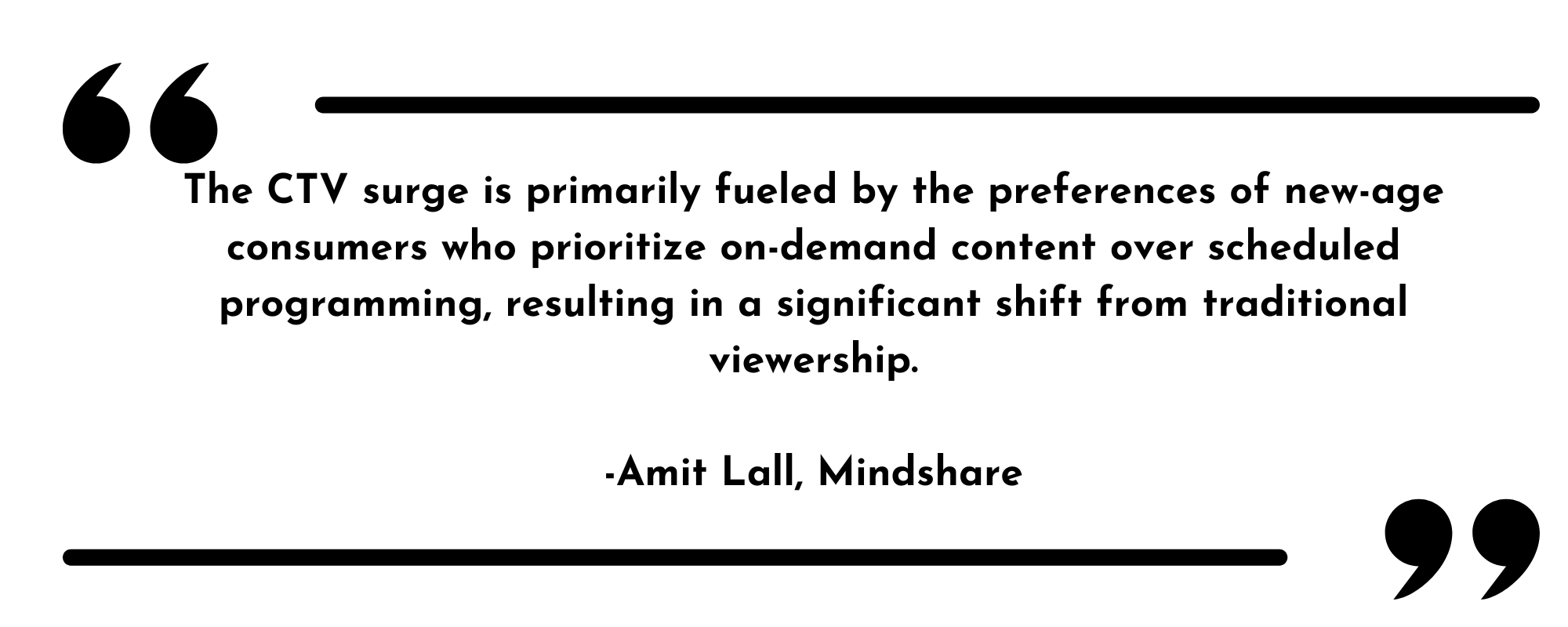
Consumer viewership habits have also evolved over the period of time. What metrics and goals do you look to accomplish for CTV vs Mobile advertising? Can you throw some light on the CTV advertising landscape in India?
India’s CTV ecosystem is experiencing unprecedented growth, reaching 33 million households in July 2023, a substantial increase from the 11-12 million recorded in January 2022. Projections from the GroupM Finecast report suggest a trajectory toward 50-60 million households by the end of 2025. This surge is primarily fueled by the preferences of new-age consumers who prioritize on-demand content over scheduled programming, resulting in a significant shift from traditional viewership. The convenience of accessing content anytime, anywhere has prompted a surge in viewers cutting the cord and embracing CTV. For advertisers, the appeal lies in the larger screen and premium ad environment, translating to a more impactful reach, with key metrics centered around impressions, viewability, and overall reach.
Digital marketing is a rapidly evolving landscape in which, Programmatic digital out-of-home (pDOOH) seems to be the new trailblazer marketing strategy everyone wants to undertake. What are your thoughts on this?
Digital OOH has changed the role of the OOH medium. From just being a ‘reminder’ medium, DOOH has also made it a medium to enhance imagery. The OOH industry has historically grappled with challenges related to transparency and measurement. However, with the emergence of pDOOH, both of these concerns are being addressed. Unlike the static-only medium, pDOOH provides a plethora of options, allowing you to play with formats such as video, staticads, and GIFs, enabling sharper targeting, and in some cases, even retargeting your consumers. These possibilities make this medium more effective.
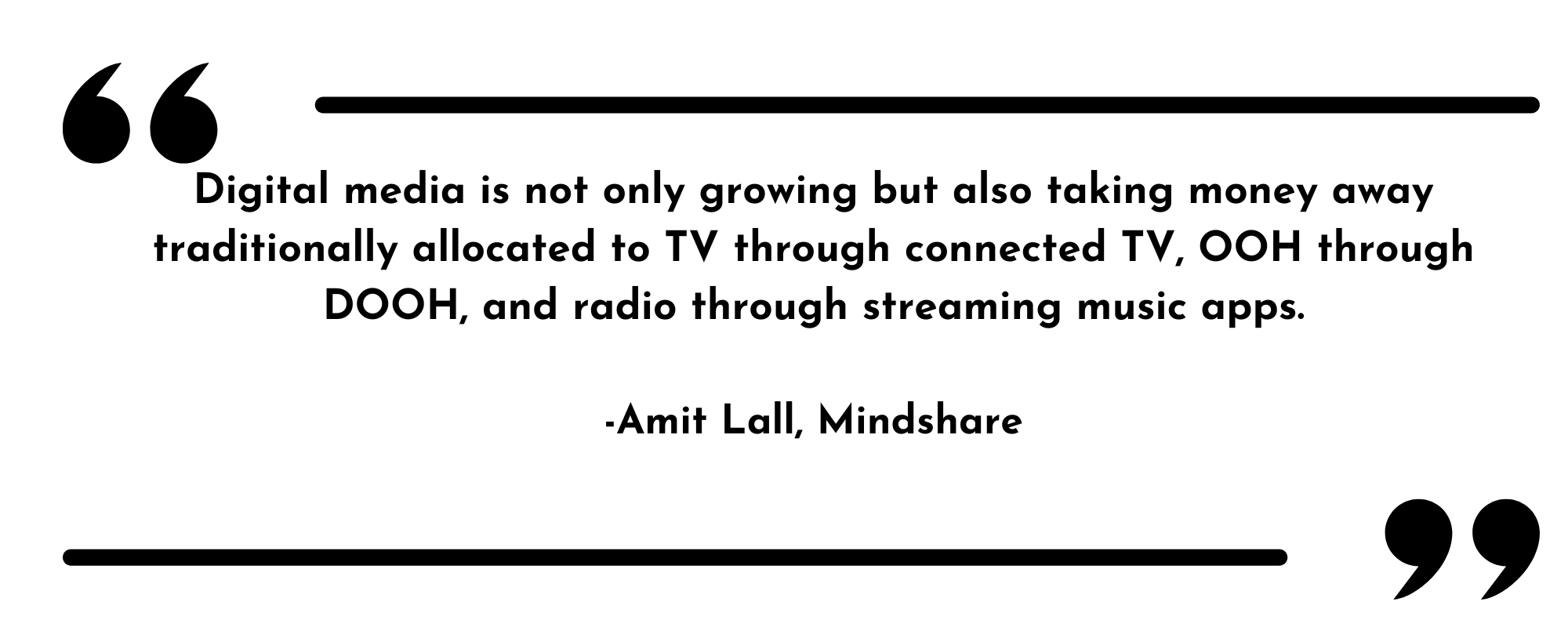
Have you ever run a marketing campaign that presented an unexpected challenge or outcome? How did you implement the lessons learned?
All campaigns are unique and designed with business objectives in mind. Based on the objectives, our solution isalways consumer-centric, powered by data. To drive engagement, we use dynamic creatives at scale, keeping the consumer’s journey in mind.
Any words of advice you would like to share with the young professionals about navigating through the ever-evolving marketing landscape?
My advice to young professionals is to stay curious and keep upskilling to adapt and stay relevant in the ever-changing media landscape.
Dentsu and Meta Partner for WhatsApp Business Customer Relationships Solution
Dentsu became the first global agency network solution provider for WhatsApp Business, after announcing a global partnership with Meta. For WhatsApp, the company’s encrypted messaging platform, Dentsu will supply customer relationship management solutions. First launching in the UK, the partnership adapts to the changing ways in which consumers interact with brands, allowing businesses to provide more customized services and build stronger relationships with customers. Users of WhatsApp Business will have access control over who can access their accounts, as well as analytics and optimization tools provided by Merkle, Dentsu’s customer experience management subsidiary.
Partnership for customer relationship management solutions
Dentsu and Meta have partnered to drive innovation and experimentation, resulting in significant improvements for their clients. The partnership is based on Dentsu’s three-way satisfaction in business, people, and society activities, or the Sanpo Yoshi principles. Every week, more than 200 million WhatsApp Business users use the platform to create hyper-personal, social, and conversational connections between brands and consumers. Dentsu’s clients will be able to further customize their customer engagement strategies to support their service, commerce, and loyalty experience journeys thanks to this innovative integration. With the help of its media, creative, customer, and data capabilities, Dentsu hopes to drive people-centered transformation and enable end-to-end business messaging solutions.
Read More: Dentsu India Appointed As BharatBenz’s Integrated Communication Partner
Dentsu’s Proprietary Web Platform
Dentsu has developed a proprietary web platform for customers to manage all access to their accounts, allowing for streamlined access to WhatsApp Business. Through its Merkle brand, Dentsu offers an end-to-end managed service that includes creation, analysis, and optimization. By providing seamless customer journeys across media, customer engagement, and service, Dentsu is enabling businesses to capitalize on the enormous engagement and conversion potential of this channel. Through the Meta family of apps, the partnership uses experience and recent developments in AI to jointly develop first-to-market media and brand activation products and solutions.
Here’s what they said
Angela Tangas, UK&I CEO at dentsu said,
Customer-brand communications are in the moment and increasingly conversational. It needs to be easy and brands that embrace conversational experiences will be well-positioned to thrive. Our relationship with Meta is focused on helping brands achieve deeper engagement and value with their current and prospective customers, a critical enabler for growth. Launching a WhatsApp conversational solution, builds on our commitment to creating seamless E2E experiences. This enables brands to establish stronger, more relevant, one-on-one connections with customers, fostering trust and enhancing service experiences in the process.
Derya Matras, Meta VP of Northern Europe Middle East Africa added,
For people and businesses across the world, WhatsApp is a great place to get business done. We’re looking forward to seeing how dentsu brings the power of messaging to its customers around the world so they can accomplish more right within a chat.
Read More: Aalap Desai, Ex-CCO, Dentsu Creative India Launches TGTHR, a full-funnel ad agency
Swiggy To Continue With Havas Media Group India for Media Duties
Swiggy, an online meal ordering and delivery service, has concluded its media pitch. For its media responsibilities, the business has decided to continue to work with its long-standing partner, Havas Media Group India. In September of this year, the company requested that its media duties account be reviewed.
Havas’s Media Duties for Swiggy
The Swiggy account is valued at approximately INR 200 crore. More than 10 noteworthy agencies participated in the pitch process. The account was won by Havas Media Group India in 2016 after a multi-agency pitch that was started in August. Swiggy reportedly spent between INR 250 and 350 crore on advertising in 2023, according to the Pitch Madison Advertising Report.
Read More: Havas Announces Majority Stake in Klareco Communications
Publicis Names Rajdeepak Das as South Asia CCO; Chairman, Leo Burnett South Asia
Publics Groupe has promoted Rajdeepak Das to Chief Creative Officer, at Publicis Groupe South Asia, and Chairman of Leo Burnett, South Asia. Das’s appointment demonstrates the Groupe’s emphasis and dedication to world-class, inspirational creativity that develops brands through contemporary, purpose-driven work.
Focus on transforming client businesses
Das will concentrate on advancing the Groupe’s creative agenda in these newly established roles by utilizing the alchemy of technology and data to transform client businesses. To support these directives, he will collaborate closely with the Groupe’s creative, data, and technology talent.
Das’s leadership experience
Das is a superb creative leader with more than 20 years of successful brand development experience. Leo Burnett India has produced performances both domestically and internationally under his direction. The agency has won the Asia-Pacific Creative Agency of the Year at Spikes Asia 2023, the Most Awarded Indian Agency at the Cannes Lions 2023, The One Show 2023, Adfest 2023, and D&AD 2023 under his leadership. He is the recipient of over 100 international awards. Being a strong advocate of the ability of modern creativity to change people’s lives and an early adopter of cutting-edge concepts and technologies, some of his most notable campaigns have been wildly successful. These include “SmartFarms” for PepsiCo, “Say It With Oreo” for Mondelez, and “PumaDive” for PUMA.
Read More: Equativ and Greenbids Partner to Power Sustainable Programmatic Operations
Here’s what they said
Anupriya Acharya, South Asia CEO, Publicis Groupe said,
I have really enjoyed working with Raj as his ideas and creativity continue to fuel both business impact and accolades. His quest for world-changing brand ideas is truly remarkable. His scintillating, sustained performance, ability to transform agency culture and reputation, as well as the width of the work that captures innovation, business transformation, data and sustainability, make him an ideal choice. We hope to leverage these strengths on a larger Groupe canvas.
Rajdeepak Das added,
I am super-delighted to get such a large canvas! With the breadth of capabilities at the Groupe level, a repertoire of finest clients and brilliant diverse talent, the opportunities are limitless. It’s been a truly exhilarating ride for me so far, and the new mandate (s) make it even more exciting. I look forward to redefining creativity and driving brand impact, as also positively shaping communities through powerful, progressive work.
Read More: Publicis Media, UK AOP To Test Privacy-Enhancing Technology (PETs)
Prasanth Kumar re-elected as AAAI’s President for 2023-2024 term
At the AAAI Annual General Meeting on December 1, Prasanth Kumar, CEO-South Asia of GroupM Media (India) Pvt Ltd, was re-elected to the position of President of the Advertising Agencies Association of India (AAAI) for the 2023–2024 term. The Association unanimously chose Rana Barua, Group CEO of Havas Worldwide India, as vice president. As the immediate past president of AAAI, Anupriya Acharya, Chief Executive Officer of Publicis Group South Asia, will serve as an ex-officio member of the AAI Board from 2023 to 2024.
Other elected members of the AAAI Board
- Sam Balsara – Madison Communications Pvt. Ltd
- Tanya Goyal – Everest Brand Solutions Pvt Ltd
- Vishandas Hardasani – Matrix Publicities and Media India Pvt Ltd
- Mohit Joshi – Havas Media India Pvt Ltd
- Kunal Lalani – Crayons Advertising
- Chandramouli Muthu – Maitri Advertising Works Pvt Ltd
- Sridhar Ramasubramanian – Beehive Communications Pvt Ltd
- Vikram Sakhuja – Platinum Advertising Pvt Ltd
- K Srinivas – Sloka Advertising Pvt Ltd
Read More: GroupM and Google Announce Post Third-Party Cookie Readiness Program
Here’s what they said
Prasanth Kumar, CEO-South Asia of GroupM Media (India) Pvt Ltd said,
I am deeply grateful to the members of the AAAI for re- electing me as President, a role I accept with great honor and responsibility. Our collective vision is to strengthen an inclusive environment, actively engaging with all stakeholders to shape a dynamic and future-ready organization. Our commitment is steadfast in strengthening unwavering support for every member, recognizing that while we have achieved a few milestones together, there is still a considerable journey ahead. This prospect excites us; it fuels our motivation. When we collaborate and exert our combined efforts, we not only enhance each year for everyone involved but also solidify our resolve to be architects of change within our industry. We stand dedicated to not just witnessing but actively creating a transformative era, steering our organization towards new horizons of innovation and impact.
On his appointment as Vice President, AAAI Rana Barua commented,
I am passionate about policymaking that leads to impactful and positive changes to the advertising industry, that benefit all the stakeholders, including, media, consumers, and advertising agencies. I believe in the potential of advertising to foster economic development and enhance meaningful social changes. I look forward to collaborating with the AAAI members to bring these shared goals to life.
Read More: Havas Announces Majority Stake in Klareco Communications
Decoding Media Evolution with Shailesh Kapoor of Ormax Media
Shailesh Kapoor, CEO of Ormax Media, brings two decades of expertise to the Indian media industry. In this interview, he discusses the industry’s evolution, emphasizing the role of audience data and analytics at Ormax Media.
He sheds light on successful marketing strategies and the impact of influencer marketing in India. Discover how his insights and Ormax Media’s innovation collectively shape the industry, offering consumer-centric solutions and steering the future of media.
Having worked in media, TV, and marketing for more than two and a half decades, can you share your insights and your experience over the years?
The Indian media industry was in a fairly nascent stage when I started working in 1999. Over the last 25 years, there has been significant growth, especially with the digital medium coming in over the last decade. This growth has also attracted global players to India, bringing in best practices and processes. Yet, the Indian entertainment industry remains unique, relying equally on its chaotic energy and remaining instinct-led in large parts. One of our biggest challenges at Ormax Media has been to educate the industry about the value of audience data and analytics for more informed business decision-making. This remains a work in progress, especially in the South markets, where entertainment businesses are run in a more traditional way.
Viewership habits have changed amongst the Indian audience over the years. As a seasoned expert who has witnessed the evolution first-hand, can you shed some light on today’s viewership behavior?
Each medium has its unique role in the life of the viewer, and the viewing behavior of that medium reflects that. For example, television is the family medium, allowing families to spend quality time together every night—an essential need even more pronounced in today’s digital age. Despite the decline in appointment viewing, which was once crucial for television, there’s a noticeable shift amidst shorter attention spans. Surprisingly, the decrease in appointment viewing hasn’t resulted in increased channel flipping, as viewers prefer sticking to familiar shows and channels. In this evolving scenario, the Holy Grail of television has shifted from appointment to destination, emphasizing the channel’s significance over specific time slots in the competition for viewership share.
OTT is a medium for solo consumption or with those of the same group (spouse/siblings). Hence, it’s a more personal and intimate medium. Movie-going is an outdoor activity, equally about the social and communal experience as it is about the content itself. With the advent of digital media and the manifold increase in media choices available to the audience, including social media, viewing behavior is highly distracted. Anything that cannot hold the attention of the viewer for a few minutes will be rejected.

Social media and digital media have become increasingly popular, but they have also brought with them the rise of fake news and misinformation. What are your thoughts on this? Has this shift from traditional to digital been the primary cause of declining news credibility? If so, how can we combat it?
A lot of digitally savvy audiences still use print and television to ‘verify’ the news they see on digital/social media. That is the nature of online news: It will be high on immediacy but suspect on credibility. Building a credible news platform digitally requires one to build a strong brand, and this is where legacy brands, ranging from TOI to Jagran to BBC to Aaj Tak, have an advantage. One of the reasons TV news and print medium will continue to stay relevant is the credibility they bring in.
With the diversity of content available on these OTT platforms, people are shifting away from mainstream television. What is your perspective on advertising on these platforms? Would it help brands establish equity with their audience and reach the right audience?
Digital advertising, whether through platforms like YouTube or social media apps such as Instagram or Facebook or through AVOD apps, is on the rise. This is because a significant cohort of the younger, urban audience is consuming digital content more than television. Given that India is such a vast country with varied demographics, socio-economic groups, and geographies, both television and digital advertising will continue to be strong options for advertisers to choose from. The death of TV, as is often predicted, is a Western idea. In the Indian context, both mediums have a strong standing, and advertisers must choose the one (or both) depending on what fits the context, target audience, and messaging of their campaign.

There has been a tidal wave of influencer marketing in India, especially thanks to the popularity of Indian influencers. How do you think brands and advertisers can leverage influencer marketing in India to gain brand recognition?
The choice of the right influencer is important, because influencers may give reach, but don’t always ensure message credibility. Hence, brands must be careful in selecting influencers who are credible and fit the brand, and not just those who have the reach/ followers.
Can you take our readers through some of the methodologies you use to obtain industry insights? What are a few successful marketing strategies you have seen where advertisers took advantage of data insights from Ormax Media?
This is a vast topic, and we deploy a variety of methodologies, primarily in the areas of content testing, tracking media brands and campaigns, forecasting, and analytics. Our website has details of these methodologies for those interested in more information. Our work is primarily for media platforms (film studios, streamers, TV networks) more than advertisers. However, we work extensively with advertisers to help them choose the right media options and the right celebrity endorsers, among other services.
Our tool, Ormax Mpact, helps advertisers evaluate the success of high-impact brand activation, such as a big sponsorship or a roadblock. Our tool, Ormax Celeble, helps brands select the right endorser/influencer that fits the brand profile. We also have various industry reports that help advertisers understand the market size and growth of various sectors to build an outlook toward the sector’s health.
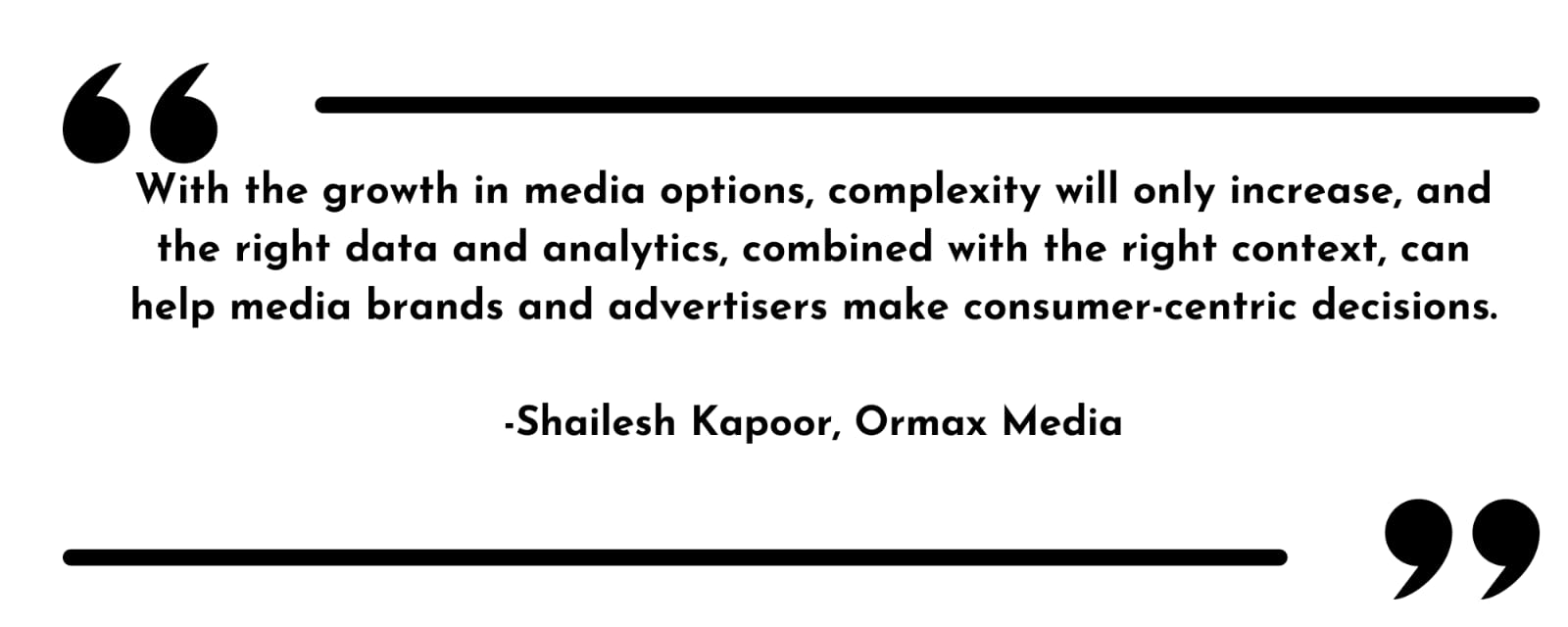
Are there any emerging or concerning trends you see in the future? How are you preparing yourself?
A definite trend that’s emerging is that the lines between different media are getting blurred. Today, Reels on Instagram are competing with long-format content like web series, for example. Yet, each medium and content type has its unique experience, making it relevant to its audience. A lot of our work post-pandemic is about understanding the nuances of media intersection. We do not buy into binary narratives, e.g., TV vs. OTT, OTT vs. theatres. Instead, our effort is to understand media intersection in the right context. For example, media choices of digital vs. TV for IPL will operate in a very different context compared to the audience’s decision to watch a new film in the theatre vs. OTT. With the growth in media options, complexity will only increase, and the right data and analytics, combined with the right context, can help media brands and advertisers make consumer-centric decisions.
Roku and Unity Announce Collaboration to Aid Mobile App Marketers
Roku, the top streaming service in the US and the world’s top platform for producing and managing real-time 3D (RT3D) content, and Unity have announced a strategic product and commercial partnership. This partnership will make it easier for mobile app marketers to extend their app install campaigns to TV streaming inventory. Through this partnership, mobile app marketers will have the only seamless TV streaming campaign execution experience possible by combining Unity’s user acquisition technology and experience with Roku’s premium inventory.
Roku – Unity solution for app marketers
The solution, which is currently in beta testing, links Unity’s Luna app marketing platform to Roku’s premium TV streaming inventory by fusing Unity’s campaign management and optimization technology with Roku’s Action Ads. With a smooth transition from ad view to download, Roku’s Action Ads offer advertisers the advantages of click-through measurement along with an easy-to-use discovery flow for viewers. They can therefore evaluate the effectiveness of their streaming TV campaigns from the point of initial ad exposure to the download of mobile apps.
TV streaming and Roku Action Ads
The first-to-market collaboration coincides with the expansion of TV streaming advertising. GroupM projects that global TV streaming ad revenue will reach $25.9 billion in 2023, an increase of 13.2%. Given that, at least 82 of the top 100 games use Unity to expand their user bases and that Roku has nearly half of all broadband homes in the United States, these two platforms are ideally positioned to assist app marketers in utilizing more screens and devices to engage potential users and spur incremental growth. Through this partnership, marketers can now take advantage of Roku Action Ads for a seamless experience in addition to closing the measurement loop for improved optimization.
Read More: Roku-Shopify Revolutionize TV Ads By Enabling On-Screen Purchases
App marketers and TV streaming campaigns
With the Roku remote, users can start the game download on any mobile device and go back to watching TV shows without any hassles. Additionally, app marketers can now track every aspect of their TV streaming campaigns, from the first TV ad exposure to the final mobile app download, which opens up new, more affordable growth strategies. When Roku’s scaled inventory is combined with Luna’s campaign management technology, app marketers hoping to boost performance on home TVs will have never-before-seen opportunities.
After logging in from Unity, app marketers will go to Luna and choose Roku from a list of marketing channels. This makes it simple for marketers of mobile apps to purchase cross-channel advertising on a single platform. After the beta test, Luna will collaborate with a select group of partners to expand to Roku.
Here’s what they said
Miles Fisher, Senior Director, Head of Emerging and Programmatic Sales at Roku said,
Mobile app marketers seek to maximize their budgets and ad opportunities. TV streaming has become the right performance channel to enable growth and provide channel diversity in a highly competitive market. Roku’s scale, tech, and direct connection with the viewer are uniquely positioned to make the largest screen in the home work harder for mobile performance marketers on Unity.
Omer Kaplan, SVP of Revenue and Operations for Unity Grow added,
The driving force behind this partnership is to turn CTV into a high-scale performance channel for apps and games. Savvy app marketers today know that they have to harness every available channel to drive truly incremental and cost-efficient growth, and CTV represents a huge and largely untapped opportunity. By coupling that scaled inventory with Luna from Unity’s robust campaign management and optimization technology, this partnership unlocks unique value for app marketers who are looking to drive performance on home TVs. We believe that there is no better combination of partners more suited to making CTV a successful performance marketing channel to add to app advertisers’ UA toolkit.
Read More: Roku and Spotify Collaborate to Introduce Video Ads To Roku App
How Ad Ops is Revolutionizing the Indian Advertising Landscape
Welcome to the world of ad operations, where advertising and optimization meet chaos and order, respectively. Ad operations are the foundation of the monetization strategy in the realm of digital marketing. Its function is basic. Make sure the publishers serve the right advertising at the right times. The management and optimization of digital advertising initiatives fall under this category. Ad operations have changed significantly over time. According to a 2022 forecast, revenue for ad media owners will increase by around 6% globally to a record-breaking $865 billion in 2023. As the decade progresses, it is predicted that the annual sum will rise even higher, hitting one trillion dollars by 2026.
Ad Ops is a crucial part of any publisher’s system. It is in charge of overseeing internet sales of digital advertisements and is the most profitable cash cow. In essence, it is a crucial element of ad tech. But what precisely are Ad Ops?
An Introduction to Ad Operations
Ad Ops, often referred to as Digital Ad Operations, is the term used to describe the systems and procedures that enable the management and delivery of digital advertisements. The term refers to any method used by a marketing team to manage, carry out, or improve advertising campaigns. Although there are more than a billion websites, it would be extremely expensive for advertisers to have their adverts seen by everyone around the globe. Instead, companies can attempt to target their ads at individuals who most closely match their existing customers using digital advertising markets. Here’s where ad ops come in.
They are in charge of placing the ads based on the likely audience, time zones, places, and regions. It will generate income in return through advertising initiatives. Ad operations technology links advertisers looking to buy ad space with websites that offer ad space for sale. Despite the fact that the majority of digital ad spaces are sold programmatically and without human intervention, ad operations play a significant role in setting up and overseeing these procedures.
Key Components
Ad operations is the fusion of many technological methods, tools, and stakeholders. The main categories in which the key elements of ad operations fall are:
- Ad trafficking
- Creating and managing ads
- Delivering and targeting ads
Ad Trafficking
Ad Trafficking means setting up and implementing an advertisement campaign so it runs in line with its goals.
- Scheduling – One of the crucial tasks for Ad Ops is to correctly decide and operate pre-fixed schedules for launching and running ads considering the timing of an ad is a key.
- Optimization – One of the most important benefits of digital advertising is the ability to get precise, real-time data on consumer behavior and advertising engagement.
Creating and Managing Ads
Involves choosing ad formats, developing ads, and managing marketing campaigns. To guarantee that ads are properly created and handled, ad ops specialists collaborate closely with advertisers and publishers.
Delivering and targeting ads
Professionals in ad operations employ a variety of targeting strategies, including behavioral and demographic targeting.
- Ad Performance Analytics – To optimize ad campaigns and boost performance, Ad Ops specialists track and analyze data on ad performance.
- Privacy and Ad Compliance – Ad Ops experts must make sure that ads are delivered in a way that respects user privacy and adheres to applicable laws.’
Read More: 10 Game-Changing AI Tools for Digital Marketing in 2023
Advertising Landscape in India
With cutting-edge digital technology becoming more popular than ever in the market, the Indian advertising sector is set to reach new heights. Due to the pandemic, the advertising industry has been struggling to survive the past two years. However, indications show that the Indian advertising sector has been progressively recovering. The market size was INR 743 billion in 2022, and by 2028, it is anticipated to be INR 1,412.5 billion. It has a growth rate of 11%. The Indian advertising industry is expanding at an unprecedented rate, and digital advertising is flourishing. In an effort to reach the target demographic, brands and advertisers are using agile strategies to use digital advertising.
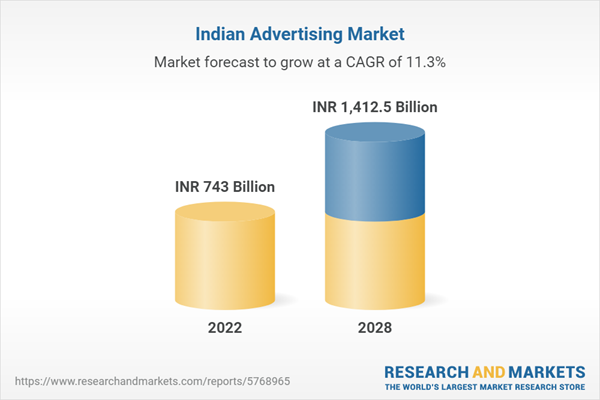
Image credit- Research and Markets
With every second that goes by, the Indian advertising scene continues to grow. Advertising experts adopted a 360-degree strategy as technology improved to include existing and upcoming digital media. Advertising in India, a now-vast industry, is set on being the second-fastest growing advertising market in Asia. It is now more data-driven, with thorough client journeys, mass-customized messages, and attractive deals.
Benefits and Drawbacks of the Ad Ops in the Advertising Landscape
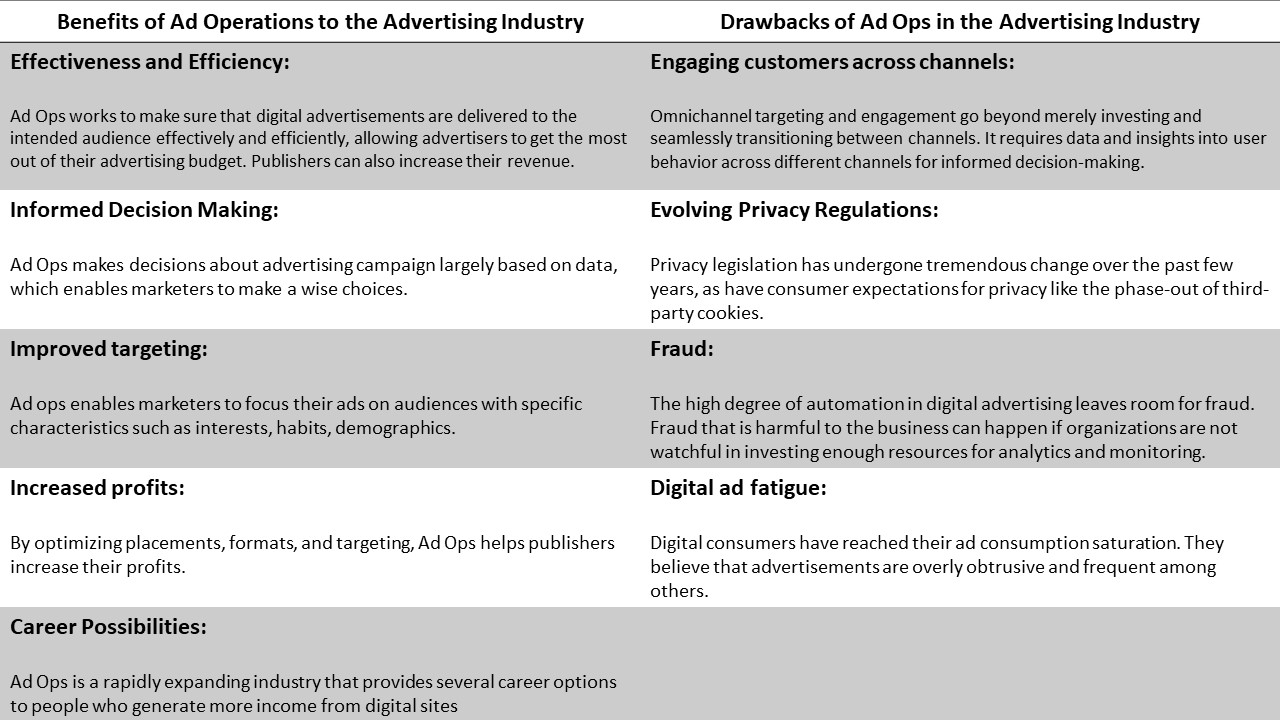
Read More: Cracking the CRED Code: A Deep Dive into its Advertising Mastery
Case Study for Brands Who Leveraged Ad Ops
In India, Zomato is a well-known B2P app for food delivery. Zomato’s excellent marketing campaign has been one of the primary causes of this enormous increase in revenue. It has made it a priority to connect with its target market consistently. Zomato grew when internet marketing became mainstream in India. For instance, appealing ad words on billboards and SMS messages to the target population showed a firm belief in their advertising skills.
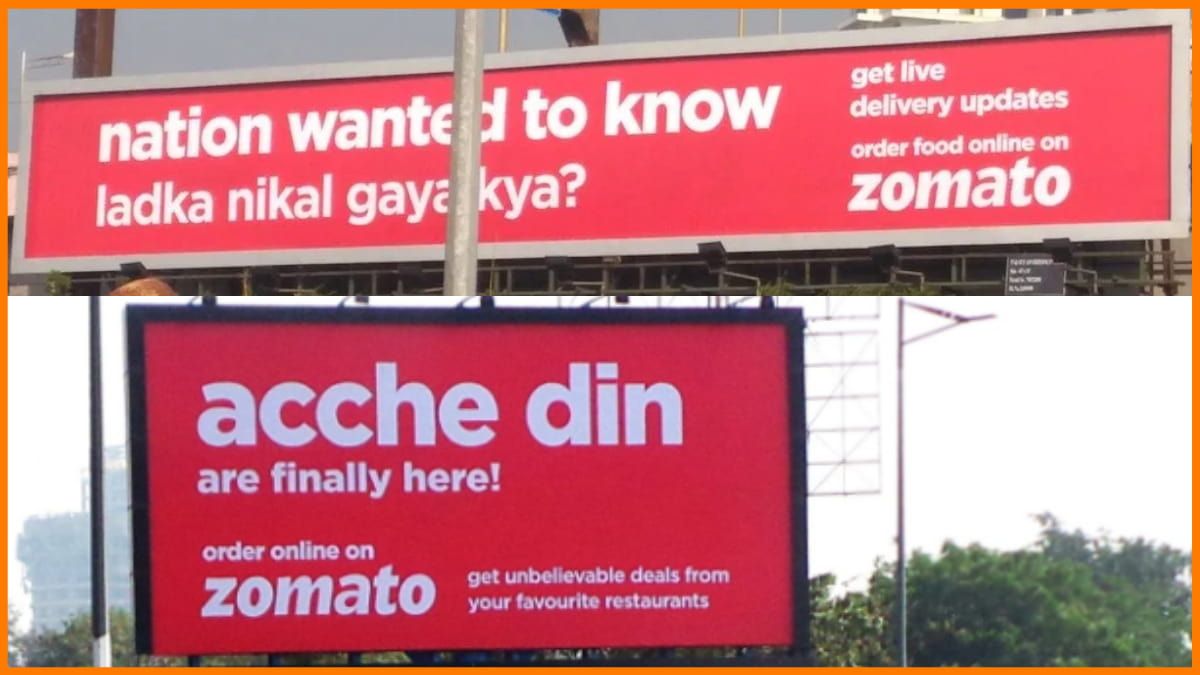
Image credit- Startup Talky
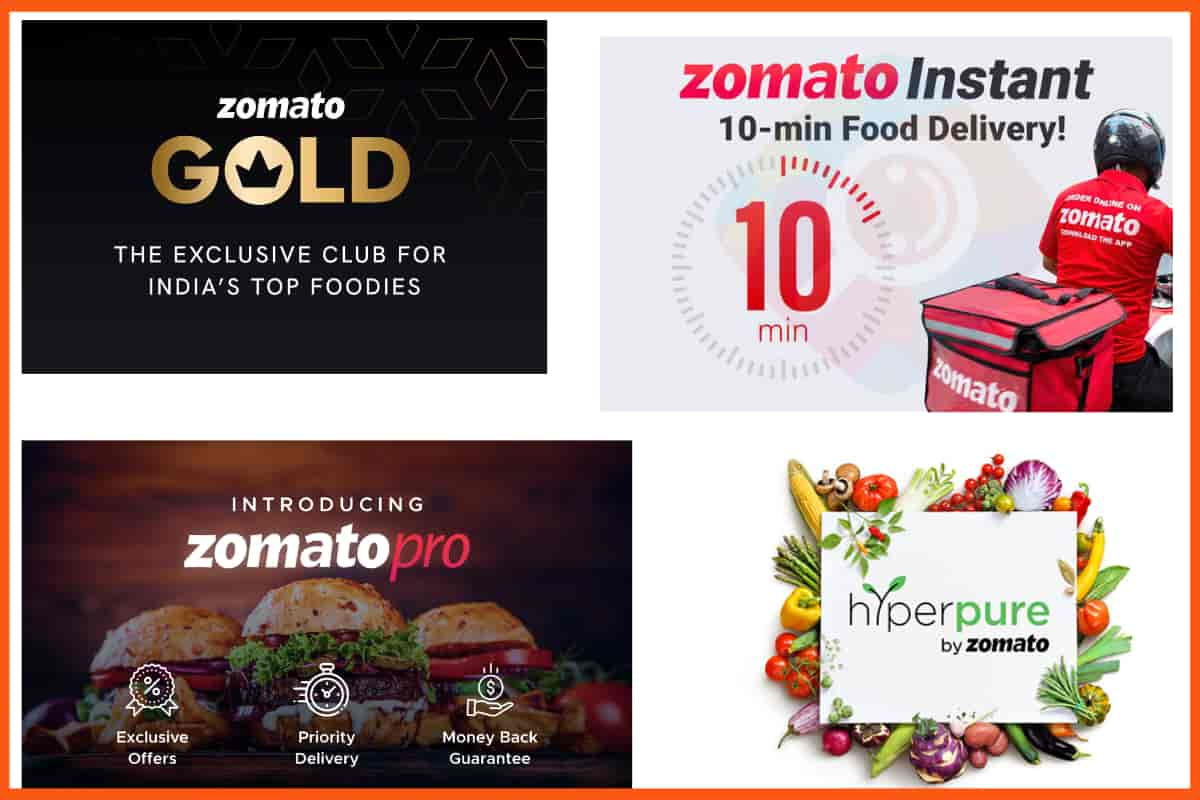
Image credit- Startup Talky
Here are some ways that Zomato’s marketing and ad operations techniques contributed to the app’s success.
- Wide-range and Powerful Outreach
- Email Tactics
- Using Social Media
- SEO Efficiency
Wide-range and Powerful Outreach
Zomato used a variety of outreach strategies in its marketing initiatives. It involves paid advertisements, email and SMS lists, and social media strategy. They studied consumer traits, ordering trends, and peak ordering hours to tailor ads for Zomato’s user base.
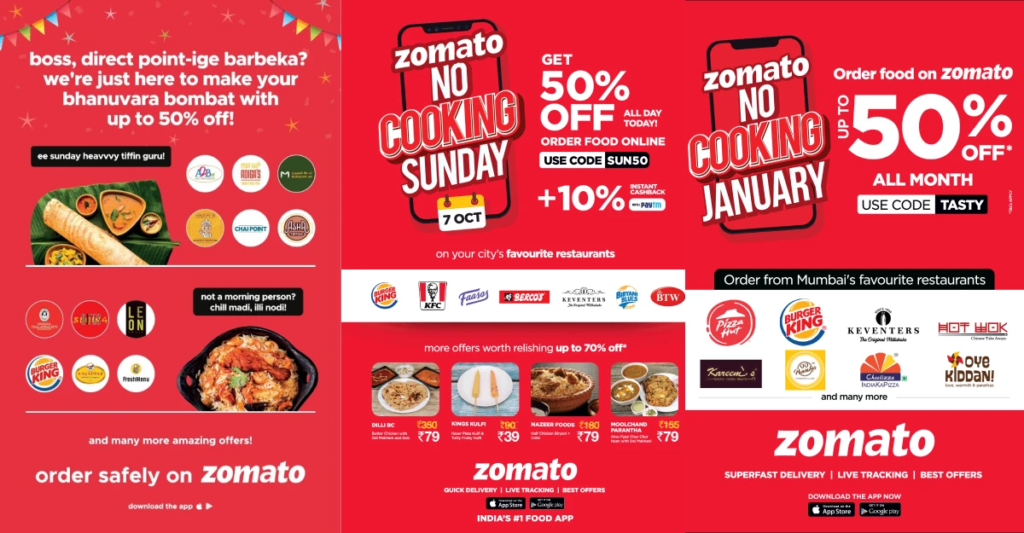
Image credit- The Business Rule
Email Tactics
Zomato targeted a potential niche by curating its emails to implement marketing strategies centered on the binge-watching culture that goes hand in hand with food.
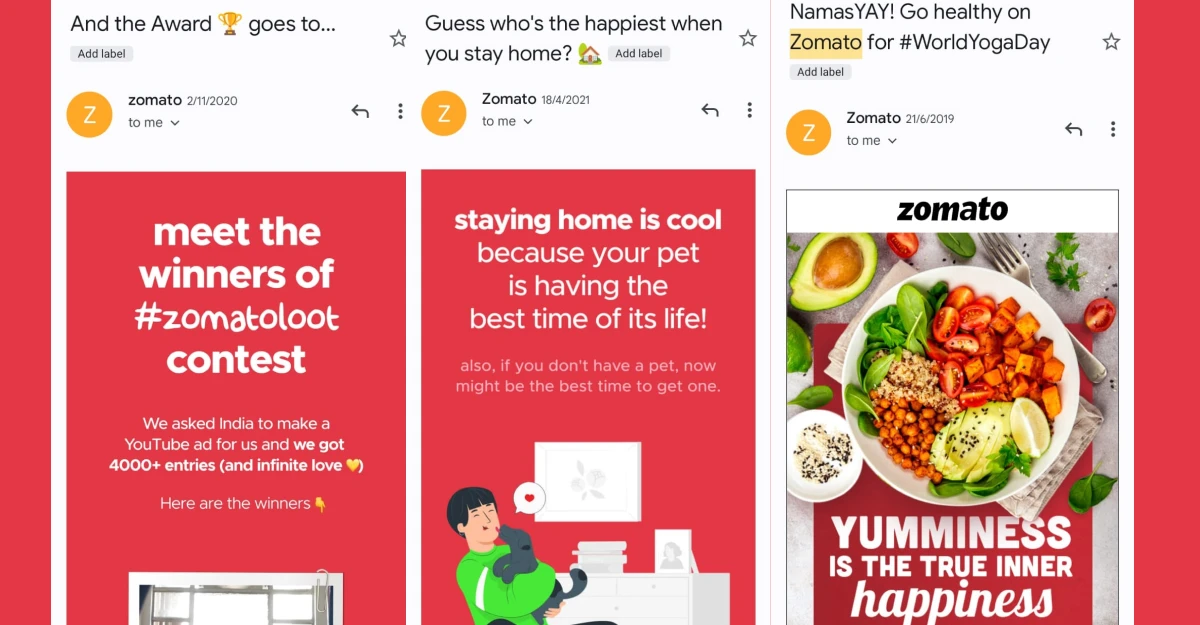
Image credit-The Business Rule
Using Social Media
Zomato depicts itself on social media with postings that are engaging on an emotional level. They interact in regional languages and make humorous memes to participate in meme
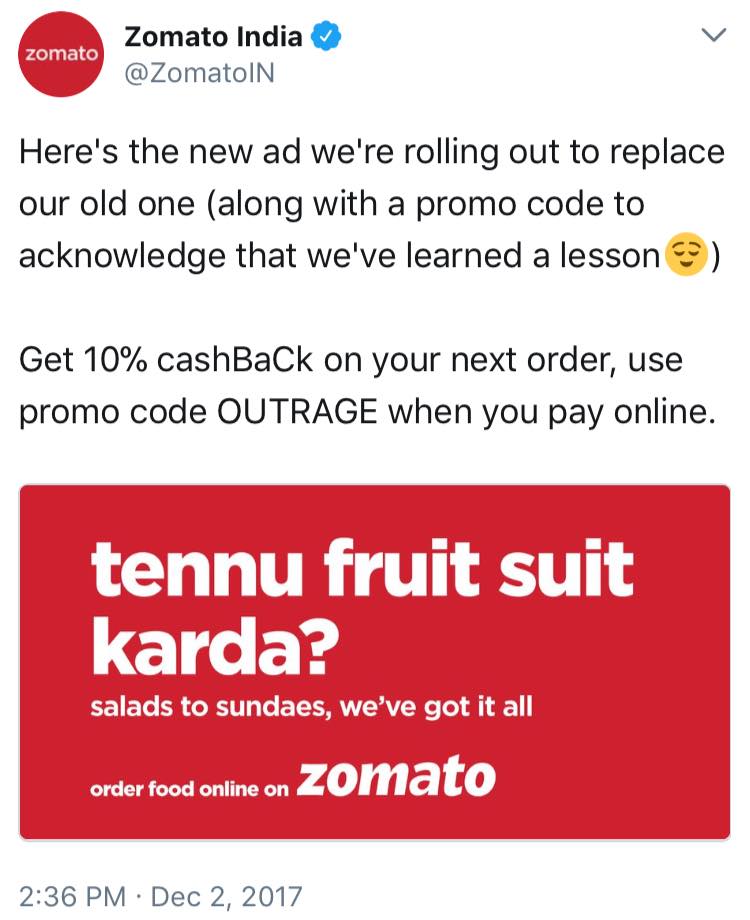
Image credit- Social Samosa via Facebook
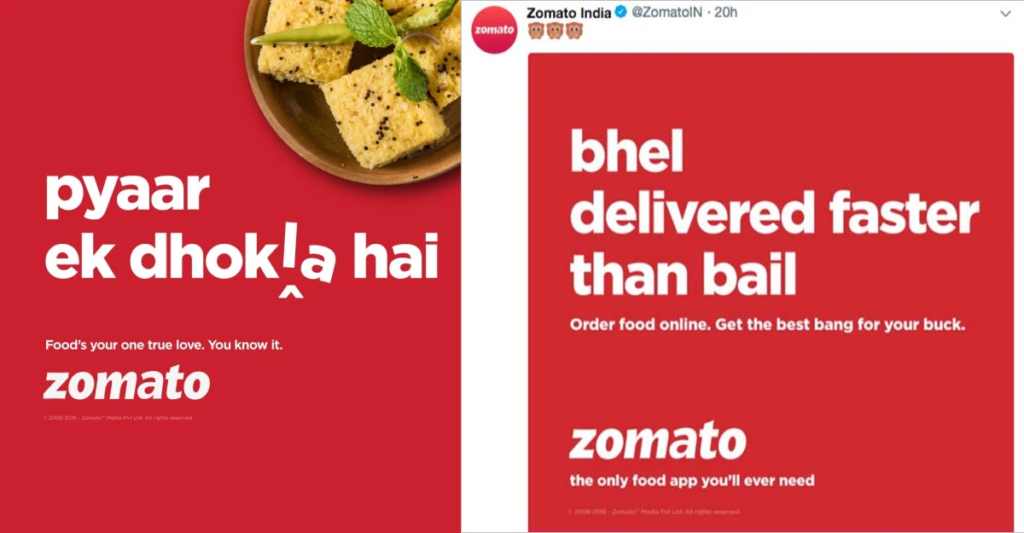
Image credit- The Business Rule
SEO Efficiency
Zomato has produced extremely keyword-dense material that has drawn more than 67 lakh internet visitors.
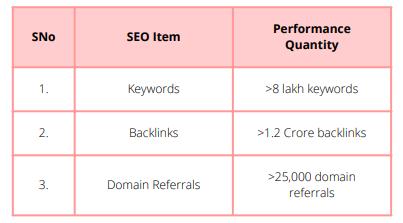
Image credit- iim skills
Zomato has a lot of influence because of its unique strategy of putting novel concepts into action on various fronts. It has always been a top priority for them to pay heed to customer comments and answer as soon as feasible.
Read More: An Innovative Triumph: Burger King x Stevenage FC Case Study
Myntra, a top-tier Indian online apparel retailer, boasts a remarkable “rags-to-riches” journey. Renowned for quality products and stellar customer service, its marketing plan revolves around key pillars for success.
- Content Marketing
- Social Media Marketing
- SEO Efficiency
- Paid Advertising
Content Marketing
Myntra has a popular blog that discusses a wide range of fashion, lifestyle, and trend-related topics. This makes the site one of the most well-liked fashion blogs in India. It leverages content marketing to establish connections with other brands and influencers.
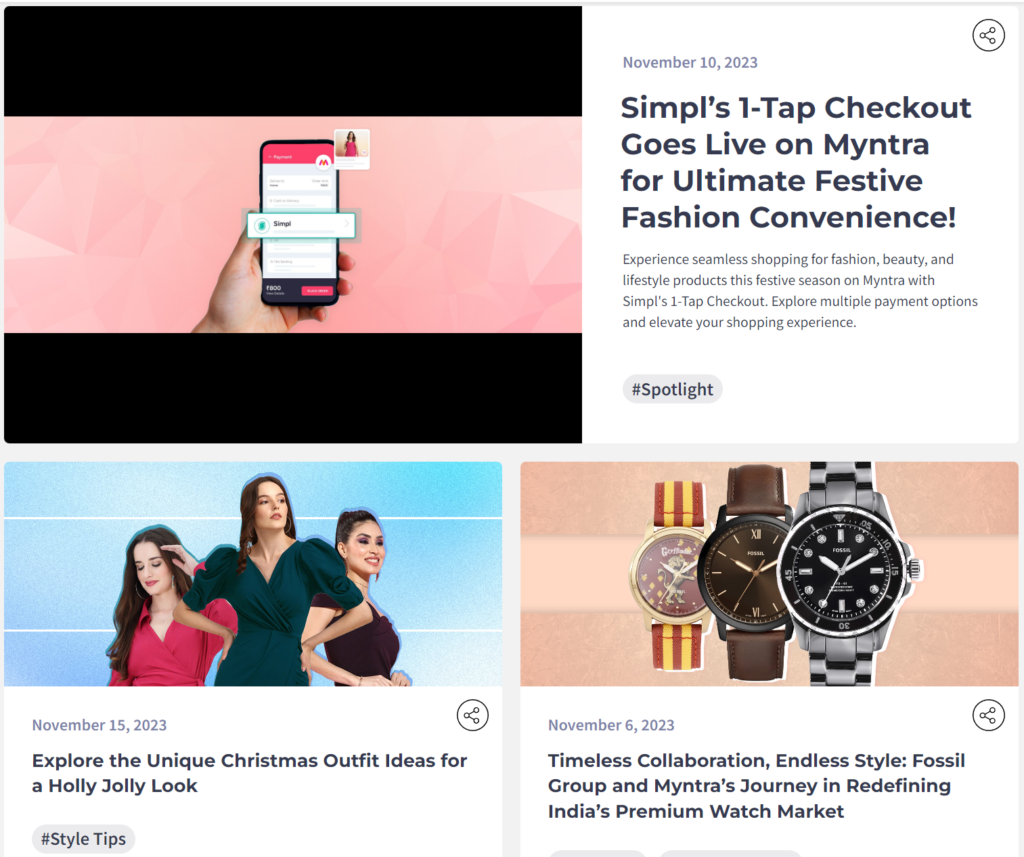
Image credit- Myntra
Social media marketing
Myntra keeps a strong social media presence to ensure its target audience is always aware of the latest content. It routinely undertakes social media campaigns that support the development of the brand’s feeling of community. Additionally, it assists in providing a supply of user-generated material for advertising needs.

Image credit- Indian Retailer
SEO Efficiency
Myntra makes use of SEO to make sure that its website ranks as highly as possible for the right keywords. To do this, they incorporate relevant keywords and phrases into the website text.
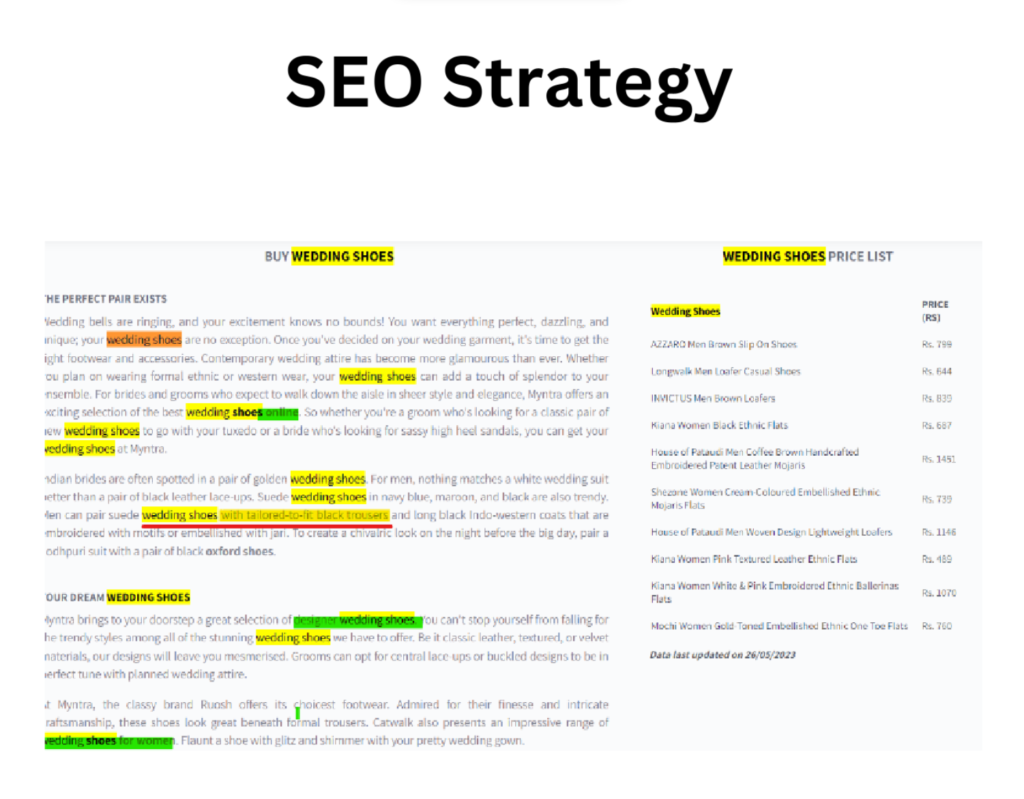
Image credit- Madhu Sudanan via LinkedIn
Paid Advertising
Myntra promotes its website and goods through paid advertising. They employ a variety of strategies, such as display, retargeting, and pay-per-click (PPC) advertising. These techniques enable Myntra to efficiently promote its brand to a large audience.
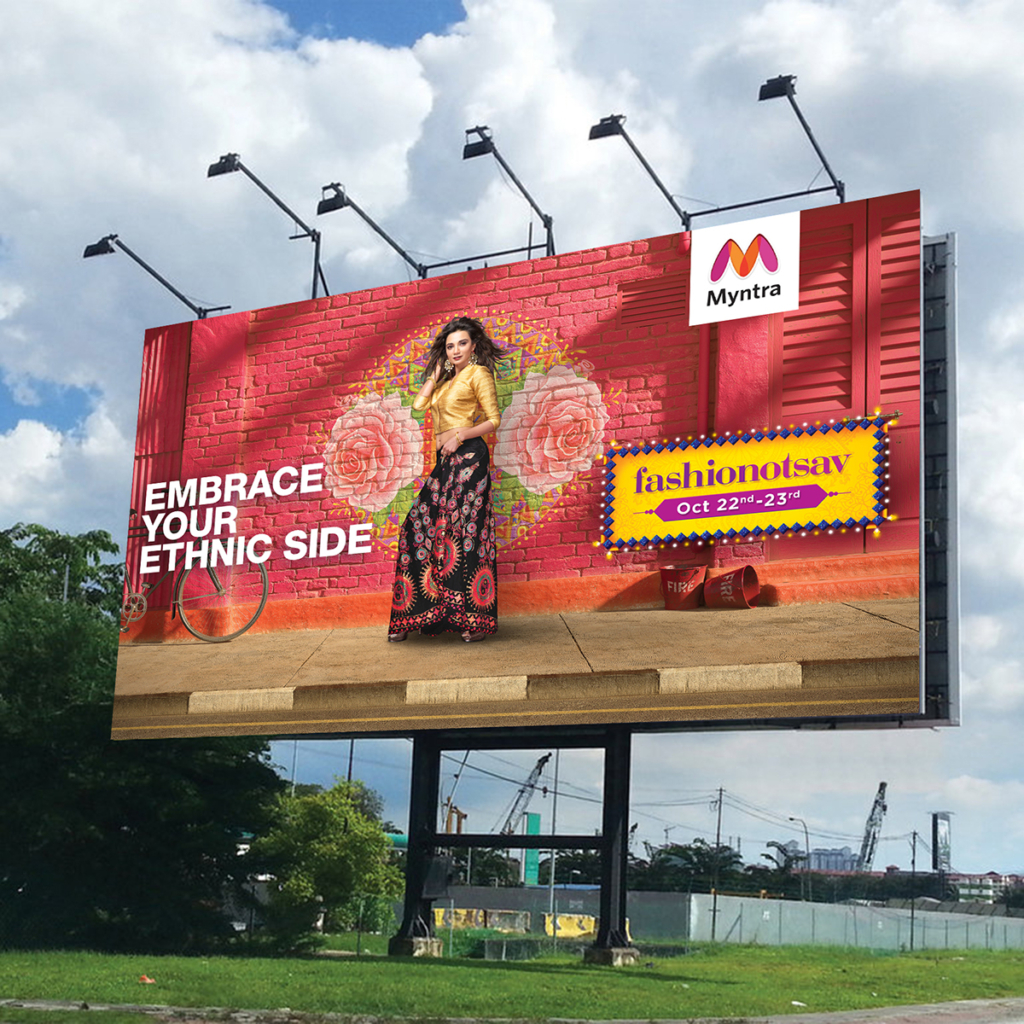
Image credit- Afaqs
Both businesses saw enormous success as a result of their marketing plans and ad operations. These businesses would still be unknown if they had not reached their target audiences at the correct time and through the right channels. Zomato and Myntra needed to avoid bombarding customers with frequent and unnecessary ads to provide an excellent customer experience. They were aware of the demographics and preferences of their audience. Both businesses achieved the ideal mix between client satisfaction and revenue generation. The organizations were able to make informed decisions due to their comprehensive insights.
The Future of Ad Ops in India
Ad operations teams will need to embrace newer platforms and follow the lead of younger demographics as the Indian advertising market continues to grow. Digital-out-of-home (DOOH) advertising tools are among the new technologies that enable marketers to reach audiences in public spaces with customized content. Moreover, it’s clear that ad operations are no longer only a tactical role. Ad operations teams are already becoming more strategic, leveraging technology to solve business challenges and playing a key role in revenue growth because of their close relationship to revenue. However since digital media is always changing, ad operations professionals should expect to face a number of new difficulties in the coming years.
- The volume of campaigns will keep growing at an exponential rate.
- The range of available ad formats will increase.
- Utilizing first-party data effectively will be essential—even more so than it is now.
- Changes in policy will be implemented on a worldwide, regional, and national scale.
- There will be more pressure on companies to maintain high margins while increasing revenue.
- Publishers will see that ad ops teams with a tech focus can directly affect revenue.
- Ad ops teams’ increased awareness of revenue workflows and data will help them move closer to the strategic side of the business.
Another important factor in digital marketing will be the development of technology. Fortunately, generative AI has made it simpler for ad operations teams to create more content in greater quantities intended for multiple channels. This technology can be used by ad operations specialists to test ad tech platforms, generate and evaluate audience segments, and produce content in a variety of formats. Ad operations teams can concentrate more on gathering information and using data-driven insights to guide marketing and revenue decisions as generative AI enhances automation.
Final Words
Ad Ops is increasingly playing a crucial role in the Indian advertising sector by enhancing efficiency, targeting, and campaign effectiveness. In this industry, automation and personalization must be carefully balanced. Ad operations will be essential in ensuring ad viewability and brand safety as the advertising landscape changes. Cheers to the growth of ad operations and their bright future in the Indian advertising industry.
Read More: Cricket’s Advertising Blitz: Boundaries Beyond the Game!
Mindshare and Scope3 Develop Emission Scorecard for Digital Campaign
Mindshare, a media services company affiliated with GroupM and WPP, and Scope3, a collaborative sustainability platform that reduces carbon emissions in media and advertising have developed a customized Emissions Scorecard. Clients will benefit from this tool’s ability to comprehend the carbon emissions of their digital media campaigns.
Insights on Carbon Emissions from Digital Media Activities
Mindshare’s clients will have access to real-time carbon emissions data for the first time on their digital media activities at the macro (business category, brand, country, and publisher) and micro (creative format, media type, and ad environment) levels. The Mindshare and Scope3 teams have been working together for the past year and a half to refine the way emissions are measured and develop a cutting-edge emissions reporting tool for brands.
Mindshare Emissions Dashboard
The Mindshare Emissions Dashboard was created with Scope3 to report emissions of digital media activity. This is in accordance with GroupM’s carbon decarbonization methodology. Marketers can thus balance the demands of greener media with those of successful business outcomes.
Read More: GroupM Bolsters Media Decarbonization with SeenThis Partnership
Sustainable Approach
The Mindshare “Report, Reduce, Remove Initiative” included the creation of the Emissions Dashboard. This sustainable step-by-step approach aims to maximize investment in greener choices throughout the media supply chain. Furthermore, it looks to minimize disruption to business requirements. Mindshare is the only organization in the sector dedicated to the Science Based Targets initiative (SBTi). Therefore, as an agency, it must implement its reduction efforts without sacrificing effectiveness.
Carbon emissions from different media sources
A combined 7.2 million metric tons of emissions are produced annually by digital, display, and streaming advertisements, according to Scope3’s Q2 2023 State of Sustainable Advertising report. When broken down by channel, streaming contributes 3.4 million metric tons and display advertising makes up more than half (3.8 million metric tons) of the total amount worldwide.
Here’s what they said
Dhruv Menon, Director at Mindshare said,
By giving marketers a 360-degree view of the carbon impact of their digital media activity, the dashboard enables change-making conversations and discussions with advertising and publisher partners. More importantly, it will also empower media practitioners to make sustainable media buying choices with a goal of eventually reducing 50% of all digital emissions by 2030.
June Cheung, Head of JAPAC for Scope3 stated,
Scope3 emissions data pinpoints exactly where marketers can take simple, yet meaningful, actions to reduce the carbon footprint of their digital advertising. It simultaneously helps the industry more clearly see and de-fund waste across the ad ecosystem. This type of industry-wide change is only possible if marketers have the tools that allow them to make informed decisions. By being able to access emissions data directly alongside campaign data, like the Mindshare Emissions Dashboard, sustainability is no longer an afterthought, it becomes a valuable lever for improving campaigns.
Read More: Magnite Partners with Scope3 to Enhance Advertising Sustainability

